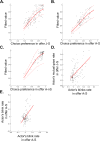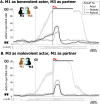Rudimentary empathy in macaques' social decision-making
- PMID: 26621711
- PMCID: PMC4687595
- DOI: 10.1073/pnas.1504454112
Rudimentary empathy in macaques' social decision-making
Abstract
Primates live in highly social environments, where prosocial behaviors promote social bonds and cohesion and contribute to group members' fitness. Despite a growing interest in the biological basis of nonhuman primates' social interactions, their underlying motivations remain a matter of debate. We report that macaque monkeys take into account the welfare of their peers when making behavioral choices bringing about pleasant or unpleasant outcomes to a monkey partner. Two macaques took turns in making decisions that could impact their own welfare or their partner's. Most monkeys were inclined to refrain from delivering a mildly aversive airpuff and to grant juice rewards to their partner. Choice consistency between these two types of outcome suggests that monkeys display coherent motivations in different social interactions. Furthermore, spontaneous affilitative group interactions in the home environment were mostly consistent with the measured social decisions, thus emphasizing the impact of preexisting social bonds on decision-making. Interestingly, unique behavioral markers predicted these decisions: benevolence was associated with enhanced mutual gaze and empathic eye blinking, whereas indifference or malevolence was associated with lower or suppressed such responses. Together our results suggest that prosocial decision-making is sustained by an intrinsic motivation for social affiliation and controlled through positive and negative vicarious reinforcements.
Keywords: emotions; eye blink; prosocial; social gaze; social neuroscience.
Conflict of interest statement
The authors declare no conflict of interest.
Figures










Comment in
-
Unnatural paradigm calls into question whether macaques' social decisions represent empathy.Proc Natl Acad Sci U S A. 2016 Mar 8;113(10):E1331. doi: 10.1073/pnas.1600575113. Epub 2016 Feb 29. Proc Natl Acad Sci U S A. 2016. PMID: 26929320 Free PMC article. No abstract available.
-
Reply to Cronin: Consistency between decision-making, gaze, and natural social behavior validates inferences on macaque social cognition.Proc Natl Acad Sci U S A. 2016 Mar 8;113(10):E1332-3. doi: 10.1073/pnas.1600687113. Epub 2016 Feb 29. Proc Natl Acad Sci U S A. 2016. PMID: 26929381 Free PMC article. No abstract available.
References
-
- Cheney D, Seyfarth R, Smuts B. Social relationships and social cognition in nonhuman primates. Science. 1986;234(4782):1361–1366. - PubMed
Publication types
MeSH terms
LinkOut - more resources
Full Text Sources
Other Literature Sources

